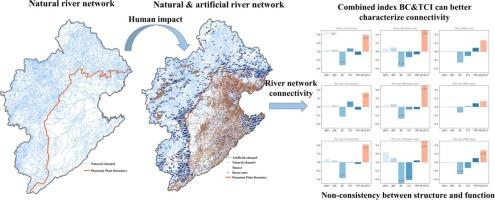关于数据稀缺流域河网连通性评价方法一致性的研究
IF 5.9
1区 地球科学
Q1 ENGINEERING, CIVIL
引用次数: 0
摘要
水文连通性是指河网输送水和相关物质的能力,可通过结构性和功能性方法进行评估。结构连通性通常使用现成的地形和河网数据进行评估,描述河网的静态布局。而功能连通性则反映了河网内的动态流动过程,通常通过可能稀缺的流量数据进行测量。虽然存在许多结构性指标,但它们代表实际(功能性)连通性的能力仍不确定。功能连通性指数(FCI)能够真实、动态地反映连通性。本研究建立了一个研究框架,用于评估结构连通性与功能连通性(将 FCI 视为实际连通性)之间的一致性。该研究框架利用地形和图形模型计算结构指标,并采用类内相关系数(ICC)评价一致性。研究以海河流域为例,分析了结构指标表征实际连通性的能力,并提出了新的指标。结果表明,Betweenness Centrality(BC)与 FCI 的一致性最高,ICC 为 0.32,而其他结构指标的一致性相对较弱。在多种情况下,由网络定义的 BC 和由地形定义的地形连通性指数(TCI)都有可能表征连通性,而且它们之间存在显著的空间差异。同时考虑网络和地形的综合指数 BC&TCI 能够更好地表征连通性,其 ICC 为 0.40,在山区的 ICC 达到 0.55。该研究框架还揭示了结构连通性与功能连通性之间的不一致性。结构连通性和功能连通性之间的不一致性可以作为河网改造和重建的衡量标准,以避免结构和功能失衡导致的生态问题。本文章由计算机程序翻译,如有差异,请以英文原文为准。

Study on the consistency of evaluation methods for river network connectivity in data-scarce watersheds
Hydrological connectivity, the capacity of a river network to transport water and associated materials, can be evaluated through structural and functional approaches. Structural connectivity, often assessed using readily available topographic and network data, describes the static arrangement of the river network. Functional connectivity, however, reflects the dynamic flow processes within the network, typically measured through flow data which may be scarce. While numerous structural indicators exist, their ability to represent actual (functional) connectivity remains uncertain.There is still no clear method for accurately evaluating connectivity. Functional connectivity index (FCI) provides a realistic and dynamic representation of connectivity. This study established a research framework that evaluates the consistency between structural connectivity and functional connectivity (considering FCI as actual connectivity). The research framework uses topography and graph model to calculate structural indicators and employs intraclass correlation coefficient (ICC) to evaluate the consistency. Taking the Haihe River basin as an example, the study analyzes the ability of structural indicators to characterize actual connectivity, and proposes new indicator. The results show that Betweenness Centrality (BC) has the highest consistency with FCI, with an ICC of 0.32, while other structural indicators are relatively weak. In multiple scenarios, BC defined by the network and Topographic Connectivity Index (TCI) defined by topography have the potential to characterize connectivity, and there are significant spatial differences between them. The combined index BC&TCI, which considers both network and topography, can better characterize connectivity, with an ICC of 0.40 and reaching an ICC of 0.55 in mountain area. The research framework also reveals the non-consistency between structural connectivity and functional connectivity. And the non-consistency between them can serve as a measure of river network renovation and reconstruction to avoid ecological problems caused by an imbalanced structure and function.
求助全文
通过发布文献求助,成功后即可免费获取论文全文。
去求助
来源期刊

Journal of Hydrology
地学-地球科学综合
CiteScore
11.00
自引率
12.50%
发文量
1309
审稿时长
7.5 months
期刊介绍:
The Journal of Hydrology publishes original research papers and comprehensive reviews in all the subfields of the hydrological sciences including water based management and policy issues that impact on economics and society. These comprise, but are not limited to the physical, chemical, biogeochemical, stochastic and systems aspects of surface and groundwater hydrology, hydrometeorology and hydrogeology. Relevant topics incorporating the insights and methodologies of disciplines such as climatology, water resource systems, hydraulics, agrohydrology, geomorphology, soil science, instrumentation and remote sensing, civil and environmental engineering are included. Social science perspectives on hydrological problems such as resource and ecological economics, environmental sociology, psychology and behavioural science, management and policy analysis are also invited. Multi-and interdisciplinary analyses of hydrological problems are within scope. The science published in the Journal of Hydrology is relevant to catchment scales rather than exclusively to a local scale or site.
 求助内容:
求助内容: 应助结果提醒方式:
应助结果提醒方式:


